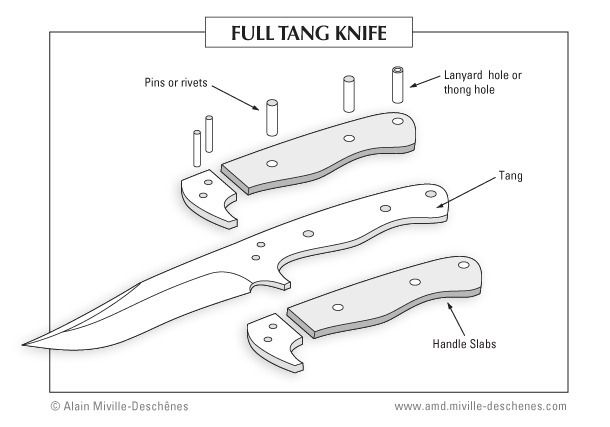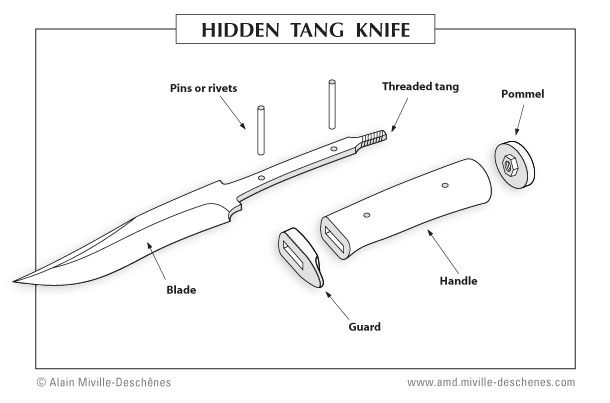KNIFE TANGS
An excerpt from the link - www.chuckhawks.com/knife_tangs.html
One of the most overlooked subjects regarding fixed blade knives is handle tangs however the focus is usually on the blade steel, pattern, size, handle material and shape. The tang is seldom mentioned.
The tang is the frame or anchor around which a complete knife is built, so it implies something about the characteristics of a knife. The distinctions among tang designs imply the capability, performance and durability of knives. The tang even affects the choice and application of handle materials, which in turn affects its ergonomics and aesthetics.
WHAT IS A TANG?
A tang is the portion of a knife that extends from the base of the sharpened blade into the handle. It is a continuation of the steel blank from which the blade is formed and all conventional knives whether folders or fixed blades have tangs.
Folding knife tangs are quite short, just long enough to provide for a pivot axle hole, plus a radius and shoulder for a back spring or latching mechanism, but tangs for fixed blade knives is where the important variations are found.
Fixed blade knife tangs fall into two basic categories…
• HIDDEN TANGS
• FULL TANGS
A hidden tang is sized and shaped so that, when handle material is added the tang will be enclosed, or hidden, within the handle.
While a full tang is formed to exactly match the profile of the finished handle and are normally attached by securing pieces of handle material on both sides of the tang with an epoxy adhesive. The tang is fully visible between the handle scales.

THE RATTAIL HIDDEN TANG DESIGN
The following schematic shows all the elements of a traditional hidden tang knife. Note that the tang is designed to run the full length of the handle and the width of the tang is significantly narrower than the width of the blade. This is called a rattail tang. It may also be called a full-length tang, but is not a full tang as described above.

The metal finger guard is slipped down the tang and rests on the shoulder formed where the blade width is reduced to the tang width. The handle material fits over the tang behind the guard and the pommel is attached to the end of the tang to keep everything together.
ARE FULL TANGS STRONGER THAN RATTAIL TANGS?
The answer is "Yes" and the logic is obvious. This can be demonstrated by placing the blades of the two blanks (Full Tang & Hidden / Rat-Tailed) in a vise and apply equal pressure to the protruding tangs. The rattail tang would surely fail before the full tang. However, the material used to build a handle on a rattail tang adds strength. This is because the handle wraps completely around the tang, reinforcing it.
Eg: The legendary KA-BAR USMC Fighting Knife and its clones became fabled combat knifes during World War II, a reputation that survives to this day. This knife has a rattail tang with a steel finger guard and pinned-on steel pommel. The handle is a set of leather disks, slipped over the tang and securely glued and pressed together. A full tang knife may be inherently stronger, but a well-made rattail tang knife is not far behind.
Briha





